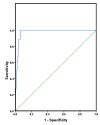Construct validity of a continuous metabolic syndrome score in children
- PMID: 20181030
- PMCID: PMC2830968
- DOI: 10.1186/1758-5996-2-8
Construct validity of a continuous metabolic syndrome score in children
Abstract
Objective: The primary purpose of this study was to examine the construct validity of a continuous metabolic syndrome score (cMetS) in children. The secondary purpose was to identify a cutpoint value(s) for an adverse cMetS based on receiver operating characteristic (ROC) curve analysis.
Methods: 378 children aged 7 to 9 years were assessed for the metabolic syndrome which was determined by age-modified cutpoints. High-density-lipoprotein cholesterol, triglycerides, the homeostasis assessment model of insulin resistance, mean arterial pressure, and waist circumference were used to create a cMetS for each subject.
Results: About half of the subjects did not possess any risk factors while about 5% possessed the metabolic syndrome. There was a graded relationship between the cMetS and the number of adverse risk factors. The cMetS was lowest in the group with no adverse risk factors (-1.59 +/- 1.76) and highest in those possessing the metabolic syndrome (> or =3 risk factors) (7.05 +/- 2.73). The cutoff level yielding the maximal sensitivity and specificity for predicting the presence of the metabolic syndrome was a cMetS of 3.72 (sensitivity = 100%, specificity = 93.9%, and the area of the curve = 0.978 (0.957-0.990, 95% confidence intervals).
Conclusion: The results demonstrate the construct validity for the cMetS in children. Since there are several drawbacks to identifying a single cut-point value for the cMetS based on this sample, we urge researchers to use the approach herein to validate and create a cMetS that is specific to their study population.
Figures
Similar articles
-
First report on the validity of a continuous Metabolic syndrome score as an indicator for Metabolic syndrome in a national sample of paediatric population - the CASPIAN-III study.Endokrynol Pol. 2013;64(4):278-84. doi: 10.5603/ep.2013.0006. Endokrynol Pol. 2013. PMID: 24002955
-
Validity of a continuous metabolic syndrome score as an index for modeling metabolic syndrome in children and adolescents: the CASPIAN-V study.Diabetol Metab Syndr. 2017 Nov 9;9:89. doi: 10.1186/s13098-017-0291-4. eCollection 2017. Diabetol Metab Syndr. 2017. PMID: 29151898 Free PMC article.
-
Use of Continuous Metabolic Syndrome Score in Overweight and Obese Children.Indian J Pediatr. 2019 Oct;86(10):909-914. doi: 10.1007/s12098-019-02994-5. Epub 2019 Jul 13. Indian J Pediatr. 2019. PMID: 31300954
-
Efficacy of a continuous metabolic syndrome score in Indian children for detecting subclinical atherosclerotic risk.Int J Obes (Lond). 2011 Oct;35(10):1318-24. doi: 10.1038/ijo.2011.138. Epub 2011 Jul 19. Int J Obes (Lond). 2011. PMID: 21772245
-
Prevalence of cardiometabolic syndrome in HIV-infected persons: a systematic review.J Diabetes Metab Disord. 2020 Jun 9;19(2):1671-1683. doi: 10.1007/s40200-020-00552-x. eCollection 2020 Dec. J Diabetes Metab Disord. 2020. PMID: 33553042 Free PMC article. Review.
Cited by
-
Metabolic syndrome in children (Review).Exp Ther Med. 2016 Oct;12(4):2390-2394. doi: 10.3892/etm.2016.3632. Epub 2016 Aug 30. Exp Ther Med. 2016. PMID: 27698739 Free PMC article.
-
The Effect of Childhood Obesity or Sarcopenic Obesity on Metabolic Syndrome Risk in Adolescence: The Ewha Birth and Growth Study.Metabolites. 2023 Jan 16;13(1):133. doi: 10.3390/metabo13010133. Metabolites. 2023. PMID: 36677058 Free PMC article.
-
Validity of continuous metabolic syndrome score for predicting metabolic syndrome; a systematic review and meta-analysis.J Diabetes Metab Disord. 2021 Apr 8;20(1):497-510. doi: 10.1007/s40200-021-00771-w. eCollection 2021 Jun. J Diabetes Metab Disord. 2021. PMID: 34222074 Free PMC article.
-
Relationships Among Metabolic-Risk, Body Fatness, and Muscular Fitness in Young Obese Latino Children.Int J Exerc Sci. 2020 May 1;13(3):488-500. doi: 10.70252/KONI3658. eCollection 2020. Int J Exerc Sci. 2020. PMID: 32509118 Free PMC article.
-
Comparison of definitions for the metabolic syndrome in adolescents. The HELENA study.Eur J Pediatr. 2017 Feb;176(2):241-252. doi: 10.1007/s00431-016-2831-6. Epub 2017 Jan 5. Eur J Pediatr. 2017. PMID: 28058532
References
-
- National Heart Lung and Blood Institute. Third Report of the National Cholesterol Education Program (NCEP) Expert Panel on Detection, Evaluation, and Treatment of High Blood Cholesterol in Adults (Adult Treatment Panel III): Final Report. Bethesda, MD: National Heart, Lung, and Blood Institute; 2002. - PubMed
-
- Khoury P, Morrison JA, kelly K, mellies M, Horvitz R, Glueck CJ. Clustering and interrelationships of coronary heart disease risk factors in schoolchildren, ages 6-19. Am J Epidemiol. 1980;112:524–538. - PubMed
LinkOut - more resources
Full Text Sources
Other Literature Sources



